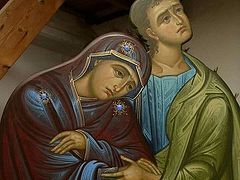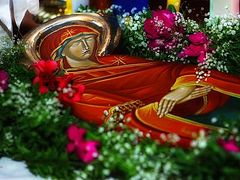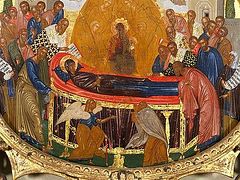On August 15/28, the Church celebrates the Dormition of the Mother of God, remembering the end of her earthly life. In honor of the feast, we offer a theological-philosophical commentary on the troparion and kontakion of the feast.
Before proceeding to an analysis of the hymns, recall that the feast of the Dormition of the Theotokos appeared in the Church year quite late. Churchwide celebration of the feast began only in the late-sixth century. Around that time is when liturgical texts devoted to the departure of Mother of God to the Lord began to be composed. The composition of the hymns dedicated to this feast was taken up by such outstanding Church poets as St. Andrew of Crete, St. John of Damascus, and Cosmas of Maiuma, who is the author of the kontakion.
As for the troparion—its author remains unknown. However, given that the text is found in the manuscripts of that era, we can say with complete confidence that the troparion for the feast was written at about the same time.
Thus, we are dealing with remarkable examples of Byzantine liturgical poetry. What does this mean for us?
For those who hear the hymns in Church Slavonic at the Divine services, much can remain incomprehensible. This is also often due to the fact that the texts being analyzed were written in ancient times, and people’s lives then were very different from ours, with different views on language, art, literature, and poetry.
Indeed, the troparion and kontakion sound completely different from the poems that modern people are used to. Nevertheless, these texts are still poetry and are also able to stir the hearts of men and reveal the beauty of theological truths, which, perhaps, often remain inaccessible to perception through strictly academic tractates. To learn to feel the harmony of liturgical poetry, it’s necessary to understand not just Orthodox theology, but also to see the specifics of the artistic language of the ancient authors. We will try to find some of these particularities in the hymns for the feast of the Dormition of the Mother of God.
Here are the texts of the hymns we’re analyzing:
Troparion:
In giving birth, O Theotokos thou hast retained thy virginity, and in falling asleep thou hast not forsaken the world. Thou who art the Mother of Life hast passed over into life, and by thy prayers thou dost deliver our souls from death.
Kontakion:
Neither the tomb, nor death could hold the Theotokos, who is constant in prayer and our firm hope in her intercessions. For being the Mother of Life, she was translated to life by the One Who dwelt in her ever-virginal womb.
The original Greek texts of the hymns are as follows:
Troparion:
“Ἐν τῇ Γεννήσει τὴν παρθενίαν ἐφύλαξας, ἐν τῇ Κοιμήσει τὸν κόσμον οὐ κατέλιπες Θεοτόκε. Μετέστης πρὸς τὴν ζωήν, μήτηρ ὑπάρχουσα τῆς ζωῆς, καὶ ταῖς πρεσβείαις ταῖς σαῖς λυτρουμένη, ἐκ θανάτου τὰς ψυχὰς ἡμῶν.”
Kontakion:
“Τὴν ἐν πρεσβείαις ἀκοίμητον Θεοτόκον, καὶ προστασίαις ἀμετάθετον ἐλπίδα, τάφος καὶ νέκρωσις οὐκ ἐκράτησεν· ὡς γὰρ ζωῆς Μητέρα, πρὸς τὴν ζωὴν μετέστησεν, ὁ μήτραν οἰκήσας ἀειπάρθενον.”
The Nativity and the Dormition
One of the features of the works of Byzantine hymnographers is the use of the techniques of ancient rhetoric. Thus, in the first lines of the troparion we encounter a vivid rhetorical figure—a parallelism: “In giving birth, O Theotokos thou hast retained thy virginity, and in falling asleep thou hast not forsaken the world.” The hymnographer hymns birth—the beginning of life—and death—its end. Moreover, birth and death, which for us seem to be polar opposites, are not contrasted in the text of the troparion. On the contrary, in this poetic figure we see a single deep meaning.
It consists in the fact that the birth and death of which the troparion speaks are uncanny events: Birth—the wondrous Nativity of the God-Man Jesus Christ, in which His Mother is a Virgin; Death—the temporary passing of the Theotokos, in which she does not forsake our world.
It’s noteworthy that Church Slavonic uses a special word for the repose of the Mother of God—“Успение (Uspenie)” (κοίμησις), which can be translated as “immersion in sleep” or “a peaceful death.”[1]
So, already in the first lines of the troparion we find one of the characteristics of liturgical poetry, which is the frequent combination of incompatible things: maternity and virginity, life and death. This manifests the special “antinomian thinking” of the Byzantine poets.
The author isn’t attempting to penetrate into the mysteries of Divine saving antinomies here, he’s simply meditating upon and hymning these unfathomable truths, poetically creating a special contemplation in words.
The Mother of Life
In getting acquainted with the texts of Orthodox liturgical poetry, one notes that they are distinguished by a special relation to Sacred Scripture. Sometimes the Bible is directly quoted, sometimes an interpretation is offered, and often the ecclesiastical poets use separate images that refer us to this or that text. Accordingly, to understand these images, you have to know the text of Sacred Scripture and see the author’s references to it.
Both in the text of the troparion and in the text of the Kontakion, the Theotokos is called the “Mother of Life.” This is a reference to the Gospel of John. The Lord Himself says of Himself: I am the Way, the Truth, and the Life (Jn. 14:6).
At the same time, “life” is also used in other meanings in the hymns we’re considering. It’s interesting to trace how the richness of this word is artistically used in the troparion and kontakion.
The word “life” (Greek: “ζωή”) has several closely related meanings. We’ve already spoken about one of these: Life is one of the names of God. Another meaning, which is often encountered in liturgical texts, is an indication of eternal life and immortality.
Thus, the texts of the troparion and of the kontakion artistically depict the mystery of salvation: In death, the Virgin Mary does not die. Due to the fact that through the Theotokos, Life—God the Savior—was revealed to the world, she passed over, or was “translated” to eternal life.
In general, the theme of eternity and resurrection permeates many hymns dedicated to the Dormition of the Theotokos, inasmuch as Orthodox Christians believe in the resurrection of the Theotokos, which occurred on the third day after her death. The kontakion states: “Neither the tomb, nor death could hold the Theotokos.”
Here we meet another feature of Byzantine poetry: the personification of inanimate objects.
Thus, through the use of Gospel images, the artistic combination of different meanings of words, and also special poetic techniques, the theme of eternity and resurrection is revealed within these texts.
Immutable hope
Examining the texts of the troparion and kontakion of the feast of the Dormition of the Mother of God, one can find many similarities in them. The same features of the poetic language of ancient hymnographers convey a common theological content.
However, if the text of the troparion focuses primarily on the contemplation of dogmatic truths, then the kontakion “depicts an event, in addition to the troparion, according to its practical significance for us.”[2]
The first lines of the kontakion speak of the Theotokos as a vigilant intercessor who ever intercedes for, that is, protects (προστασίαις) us.
The parallelism of the first lines seem to adopt a special name for the Mother of God—“hope”—which corresponds to the Greek ἐλπίς. Indeed, Christians have always turned in prayer to the Mother of God with deep hope and have especially venerated her.
This relationship has a solid theological foundation. Hymning the Virgin Mary as the Theotokos, the Church glorifies the theological truth of the Incarnation of one of the Persons of the Most Holy Trinity. According to St. John of Damascus, “this name embraces the whole mystery of the dispensation [Divine economy].”[3] If the one who gave birth is the God-bearer, then the One born of her is God, but inasmuch as He was born, He is also man.
This truth is the foundation upon which all our Christian hope is anchored, as it is thanks only to the Incarnation of God that the communion of Eternal Life became possible for every man.
The Incarnation of the Son of God is inextricably bound up with the person of the Virgin Mary. One of the outstanding Byzantine theologians—St. Nicholas Cabasilas—has this to say about it:
“The Incarnation was not only the work of the Father, of His Power and Spirit, but also a work of the will and faith of the Virgin. Without the consent of the Most Pure and the contribution of her faith, the Pre-Eternal Council could not have been carried out.”[4]
Her contribution was possible only under the condition of her highest holiness, freely achieved.
And in this holiness, in total devotion to God, the Most Holy Virgin showed an example of the highest life, which is possible for everyone. In holiness and purity, in ineffable motherhood, she has become so close to God that the Church ceaselessly turns to her as to an intercessor, a patroness, and places its hope on her and praises her as a “firm hope in … intercessions.”




